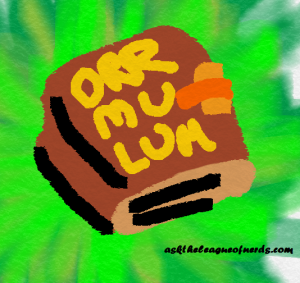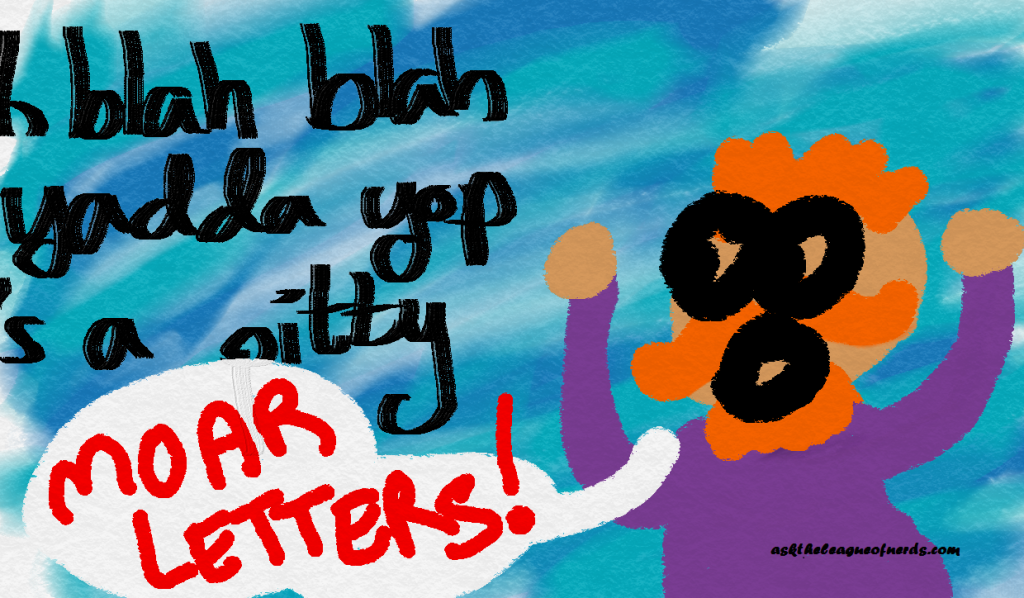Our son Anthony is in First grade and has spelling tests on Fridays from his weekly list. I’m mostly a musician but love to help him with his spelling by telling him the history of the letter K for example. Our question is this: Why do we not pronounce all the written syllables in the English language specifically the silent e. Please something on the subject or point us fruitfully in the right direction to look. I enjoy reading the League very much. Love it . thank you for sharing . first grade speller M.S.T
***
Dear M.S.T.,
First grader, huh? I guess I’ll cut back on the swearing. Just this once.
The thing to know right off is that early English spelling was a free-for-all. When monks and scribes started trying to put English on paper (or vellum), the first dictionary, the first spelling test, and the first style manual were well over a thousand years off. There was no standardization, no authority, not even the idea that one spelling was the “right” one. Most of the history of written English is a buncha folks muddling around, doing their best.
Those early monks arrived in England from mainland Europe back when years were only three digits long, about the 500s. They arrived on a damp, drizzly rock full of Angles* and Saxons and wanted to translate their prayers** for the locals to understand, so they decided to write down the language they were hearing. They already had the Latin alphabet, and they figured they could make it work.
The Latin alphabet had 23 letters: A, B, C, D, E, F, G, H, I, K, L, M, N, O, P, Q, R, S, T, V, X, Y, and Z. Notice that there’s no “U” or “W” – we’ll come back to that.*** This didn’t work out perfectly, as there were some sounds English had that weren’t covered (like the “th” sounds, which I wrote about here), but it was a good start. They used the sounds they had and matched them up as well as they could.
There were no silent letters back then. What the monks heard, they wrote. There’s a “w” in “write” and a “k” in “know” because that’s how their Old English ancestors were said: writan and cnawan started with a “w” and “k” sound, 1400-odd years ago. Pronunciation keeps changing – always has, always will.
There are tons of words in English that are only different in their vowel sound: “hop” and “hope,” “ten” and “teen,” “sit” and “site,” “cap” and “cape.” But these vowel sounds were pronounced differently back then, too. The shorter words were pretty similar, but the long ones used to be the same sounds as the short version, said longer. “Goose” would be said “gohs,” “made” would be “mahd,” “mice” would be “mees,” and so on. Get ready to have your mind blown: this is why they’re called “short” and “long” vowels.
The monks figured it was important to show the differences in these word pairs. The first idea they had for marking a long vowel was simple – double the letter. This is where we get “moon” and “queen” and the like. But they didn’t love this, especially because “ii” and “uu” were hard to read in the standard monkly handwriting. They tried putting two letters, like “ie” and “ay” and “ou.” But they were still not satisfied.
While the scribes were muttering grouchily about this long vowel peskiness, the English world was swept by another pronunciation change, this one important enough to get its own name: fronting. See, in Old English all parts of a word were pronounced pretty equally. If a monk spelled a word hete (modern “hate”), he’d know that his reader would say it “het-uh.” But as the clock ticked on and Old English became Middle English, people began to put more emphasis on the beginnings of words, and letting the ends trail off.**** This meant the ends of words were now fair game, and the monks could put a letter there as a spelling signal, to show the vowel was long. And what letter did they go for? Why, “e,” of course.
Silent “e” took off like Kendrick Lamar. It was everywhere. And it mixed with the other two ways of showing long vowels, sometimes chaotically. Remember, no authority or right choice for spelling yet – if you like doubling, go for it, and if your friend prefers silent “e,” that’s ok too. Words were written with all three long-vowel markers, or even more than one at the same time: queen, quean, quene, and quiene were all acceptable.
There was also a way to signal that a vowel was short: double the following consonant. This gave us “egg” and “fill” and showed the difference between “hopping” and “hoping.” It was never used 100% consistently, except for by one guy, a monk named Orrm. He wrote the awesomely-named Orrmulum and stuck to the double-letters-after-short-vowels idea with ridiculous tenacity. But a book full of spellings like “affterr” and “ennglissh” makes it clear why other monks thought doubling was best done in moderation.
Working together, the silent-e/doubling combo seems like a pretty sweet system, right? But there were exceptions, always, always exceptions. We’ll take just one, and it’s about those missing letters.
I was there, so I happen to know it went exactly like this.
English scribe: Life sure is great here in 1066 AD! It’s kinda weird that we use the same letter for the “V” consonant and the “U” vowel, written with a capital “V” and small “u,” but whatever, it’s cool.
French scribe: Hey! Since we showed up and conquered the crap outta you, you’re gonna need to get used to my little buddy “W.”
English scribe: Alright, he seems chill. But whoa, that causes a problem with short-vowel words that end in “V,” bro. If I do the usual thing and double the consonant, it’ll look like your “W.” People will be all, is that “lovving” or “lowing”? “Givv me a cookie” or “Giw me a cookie”?
French scribe: So don’t double it. Sheesh.
English scribe: But then they won’t know if it’s “V” or “U”! “Lov” or “lou”? “Giv” or “giu”? “Hav” or “hau”?
French scribe: Put an “e” on the end to show it’s the consonant. “Love,” “give,” “have.”
English scribe: But we already use an “e” on the end to signal a long vowel!
French scribe: Look my solution is PERFECT so just DEAL okay??
English scribe: …alright.
That’s word-for-word, I swear.
The next couple centuries were all a process of different people trying to organize spelling as best they could, adapt to new sound changes, and maybe get a little cash. Lawyers’ clerks, for one, got paid by the inch, so they tended to prefer spellings like “musiycque” over the smaller payday “musik.” And in the 1470s, when printing started to be A Big Deal, the printers just wanted their lines of type to come out even, and they threw the double-consonant-short/silent-e-long teamwork right out the window to make that happen. Big-name printer William Caxton would write had, hadd, or hadde, pity, pitty, or pittye – whatever made the line length work.
By the time of Caxton, the pronunciation of the vowel sounds was changing to what we know today, in the Great Vowel Shift (that’s not me capitalizing words for my own amusement, it’s really called that). The names “short” and “long” vowels soon stopped having such an obvious meaning. Pairs of words like “mad” and “made” were still different, though, so having something to show that difference was still handy. In 1582, Richard Mulcaster wrote one of the earliest books attempting to make standards for spelling, Elementarie, and he threw in with the monks – and became the first guy to write up a rule in support of silent “e.”
Yours,
The Language Nerd
*The adjective for “of/about the Angles,” by the way, was Englisc, which is where we got the word “English.”
**A motive that continues to play a surprisingly large role in documenting languages.
***There’s also no “J,” but that’s a post for another day.
****This also had an enormous effect on the grammar. Verbs used to have special endings for different subjects, like “-est” in “thou lovest me!” When the word-ends weren’t emphasized, this wasn’t a great way of organizing what was happening in the sentence anymore, and they dropped away, replaced by more careful word order. The only one left now is the “-s” in “he walks,” and many dialects drop that too.
Got a language question? Ask the Language Nerd! asktheleagueofnerds@gmail.com
Twitter @AskTheLeague / facebook.com/asktheleagueofnerds
This entire post, examples and all, comes from one reference: David Crystal’s Spell It Out: The Curious, Enthralling, and Extraordinary Story of English Spelling. And y’all, it lives up to that title. If you were wondering if it’s possible to be totally fascinated by a book about friggin’ spelling, the answer is yes.

